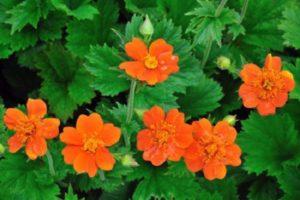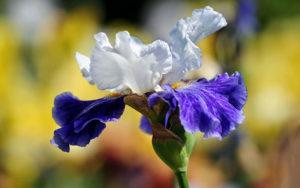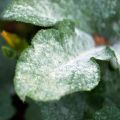Why chrysanthemums do not bloom outdoors, how to speed up the process
The flowering period of chrysanthemums begins at the end of August and lasts until October. Some varieties bloom later. Unfortunately, it happens that the long-awaited flowering never comes. Novice gardeners are often interested in why chrysanthemums do not bloom outdoors. This can be caused by various factors, each of which should be read in detail.
Main reasons
Among the main reasons for the lack of flowering of chrysanthemums are mistakes when choosing a place, a lack of space between seedlings, improper or insufficient care, diseases or exposure to pests. In each situation, you should find the right solution to the problem.
Tightness
Over time, the chrysanthemum bushes grow strongly. In conditions of a shortage of free space, the volume of nutrient soil allocated for each plant decreases. The consequence of this is a lack of oxygen and nutrients necessary for flowers. In addition, the vegetation becomes vulnerable to pests. To avoid this, you should not grow chrysanthemums in the same place for more than three years.
Plant transplanting will solve the problem of crowding. The chrysanthemum sprouts quickly. After replanting, growth and flowering become more intense.
The best time for transplants is spring. In this case, a well-rooted plant will grow by next autumn and will delight with abundant flowering.
The wrong place on the street
Chrysanthemum runs the risk of not blooming if it grows in a too dark place with high humidity. It is better to plant it on a hill, moderately lit by the sun and blown by the wind.
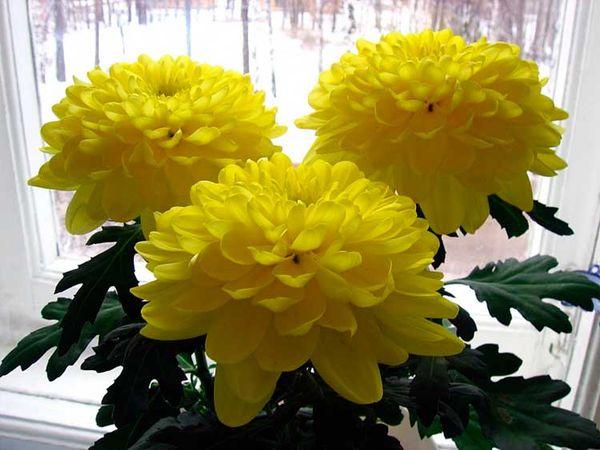
Insufficiently nutritious soil
The deficiency of beneficial nutrients in the soil composition negatively affects the flowering of garden chrysanthemums. The soil becomes depleted if chrysanthemums grow in their original places for too long. Therefore, the supply of nutrients responsible for normal flowering is completely depleted. The solution to the problem will be transplanting or feeding the plant.
Abundant watering during bud formation
During the budding period, the chrysanthemum needs a little water. Watering too often and too much will stop flowering.Instead, the plant will noticeably lengthen the stem and enlarge the leaves.
Diseases
Despite the fact that chrysanthemums are resistant to most diseases, sometimes it is this factor that prevents the onset of flowering.
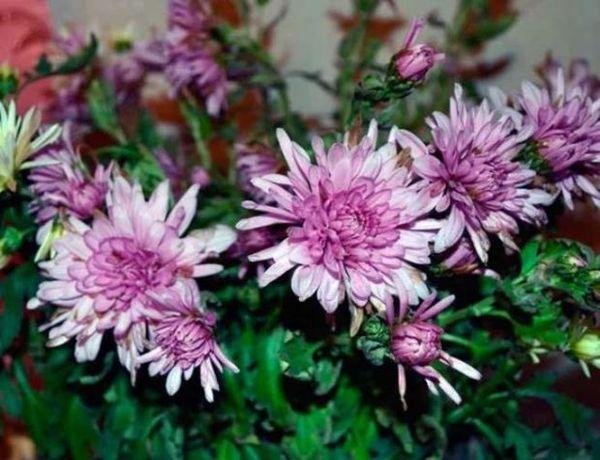
Fusarium is a fungal disease, the causative agent of which penetrates from the soil through the roots and prevents water from entering the plant tissues. As a result, the leaves turn yellow or brown prematurely, the growth of the plant slows down, and the flowers are unable to form. For treatment and prevention, universal fungicidal solutions are used.
Mosaic is a dangerous viral disease that leads to wilting and yellowing of leaves. Flowers can form, but they are too small and inconspicuous.
As a preventive measure, it is recommended to use only high-quality planting material, plant flowers at a considerable distance from each other, and timely destroy insects that carry the disease.
Unsuitable climate for the variety
Some varieties of garden chrysanthemums react painfully to changing climatic conditions. Exotic flowers imported from overseas may not feel good. Therefore, in order for the chrysanthemum to please with a beautiful and stable flowering, it is better to give preference to those varieties that are well adapted to the conditions of the local climate.
The most favorable climate for chrysanthemums is a warm, not hot climate with moderate humidity. In such conditions, it blooms earlier and pleases others with its beauty for a long time.
How to speed up flowering
There are some simple chrysanthemum care secrets to speed up flowering.
Choosing a place in the garden
When choosing a suitable place for a chrysanthemum in the garden, you need to take into account such criteria as the level of humidity, the degree of illumination and a favorable regime.
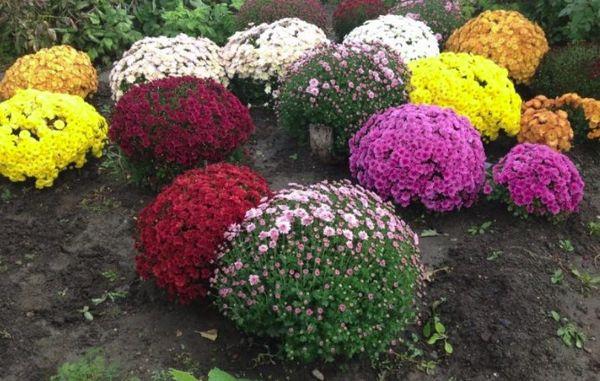
The quality and composition of the soil in the garden area is also important. She must be:
- moisture permeable;
- loose;
- saturated with nutrients;
- slightly acidic or neutral.
Illumination
The consequences of insufficient illumination are:
- pulling shoots;
- weakening of the structure of the plant;
- delay in characteristic flowering periods.
Chrysanthemums feel most comfortable in a sunny area located on a small hill.
Temperature regime
The most favorable temperature for the growth and flowering of chrysanthemums:
- in sunny weather - from +16 ° С to +25 ° С;
- in cloudy conditions - up to +20 ° С;
- at night - within + 16-17 ° С.
If +25 degrees are exceeded, chrysanthemum inflorescences burn out. The flowering period is shortened. At low temperatures, growth slows down, inflorescences are poorly formed, remaining soft and loose. In combination with high humidity, low temperatures increase the plant's susceptibility to damage by powdery mildew, gray rot and other ailments.
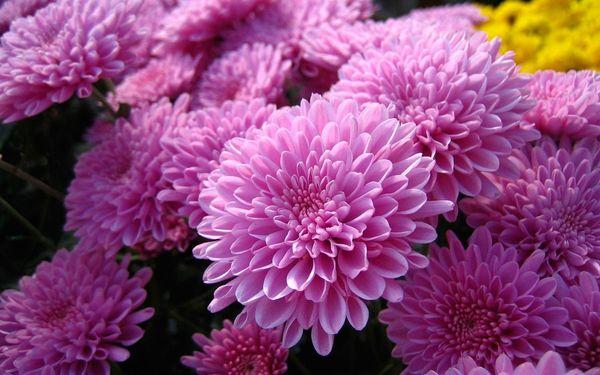
Humidity
It is highly undesirable to plant chrysanthemums in shady places where there is a possibility of moisture retention. In conditions of excessive dampness, they problematically endure wintering. Drought also adversely affects bud formation and subsequent flowering.
What top dressing to choose
Novice gardeners often have the question of how to feed the chrysanthemum for good flowering. Different remedies are used at different times of the year.
In the spring, it is required to enrich the soil with organic fertilizers. They need to be introduced to a considerable depth.
Of mineral fertilizers at the initial stage of development, nitrogen-containing options are required. They help to accelerate the climb, increase the number of young shoots, and also provide the richness of the color of the plant. When carrying out nitrogenous feeding, it is necessary to avoid getting the product on the aerial parts of the plant, since this is fraught with burns.
In summer, the use of nitrogen should be reduced to a minimum so that the stems of the plant do not become too long and the flowers are small. Give preference to potassium instead. The special regulator "Bud" is favorable for the flowering of chrysanthemums.
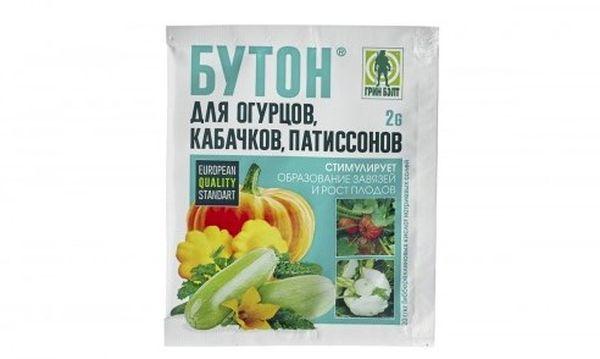
In late summer and early autumn, it is necessary to completely eliminate nitrogen from the diet of chrysanthemums. During this period, the main focus should be on potassium and phosphorus. One square meter of garden area requires 40 g of potassium and 25 g of phosphorus.
Aphid treatment
Aphids are a dangerous enemy of chrysanthemums, feeding on plant sap. As a result, the flower becomes dehydrated and deprived of nutrient minerals. This leads to drying of the shoots, deformation of the leaves and the loss of buds. Usually pests are localized on the lower part of the leaves of the plant, where you can see their accumulation.
To combat aphids, there is a wide selection of special chemicals - "Aktara", "Metaphos", "Karbofos", "Fosfomid", "Confidor" and others. The packaging of each of the products contains detailed instructions, following which you need to prepare the solution.

It is necessary to process the chrysanthemum with the resulting solution from the root part to the tips of the leaves and the uppermost buds.
In addition to ready-made chemical insecticides, there are many alternative methods of dealing with aphids. The following options are recognized as the most effective:
- Ammonia diluted with water in proportions of 1:10. This solution must be filled with a spray bottle, and then used to spray the plant. After 2-3 days, it is recommended to process the plant again.
- Grind 2-3 garlic cloves, pour 250 ml of hot water and leave for 1.5 hours. Then filter and dilute with water until a liter volume is reached. During the day, use for spraying chrysanthemums with an interval of 3-4 hours.
- Dry and chop the citrus peel. Pour a liter of boiling water and place in a dark place for infusion for three days. After that, strain the resulting infusion and use for irrigation of chrysanthemums.
Dividing the bush
The easiest and most effective way to reproduce chrysanthemums is to divide the bush. It is recommended to do it every three years. This will give the seedlings vitality and improve flowering.
For division, you need to select exclusively healthy bushes, without signs of disease or damage by pests. Up to 5-6 cuttings can be obtained from one three-year-old plant.
The mother bush must be dug up and divided into separate parts with shoots and formed roots. The resulting seedlings must be fixed in the open ground, after filling the planting holes with humus. After planting, the plant is watered.
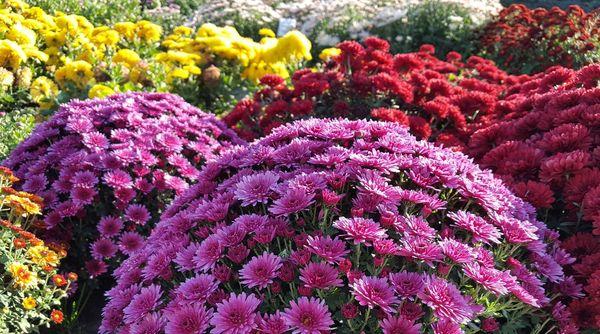
When dividing a bush in the autumn, it is required to cover young seedlings with spruce or oak branches.
How to store in winter
Successful wintering of chrysanthemums is a guarantee of their rich flowering for the next year. Different types of winter storage should be selected for different varieties of plants:
- in open ground with shelter;
- in the basement;
- in the trenches.
Frost-resistant varieties are able to spend the entire winter in the open field. However, for this they need a reliable shelter, so in autumn they need to prepare large quantities of dry leaves. The deciduous layer half a meter thick must be laid on the bushes as soon as the first frosts begin.
On top of the leaves, you need to lay additional shelter - it can be a household plastic wrap, thin dried branches or a vine. This provides protection against wind gusts.
Basement storage is optimal for most varieties. The place must meet the requirements:
- maintaining the air temperature from 0 to +4 degrees;
- good ventilation and normal humidity;
- lack of pests and fungi.
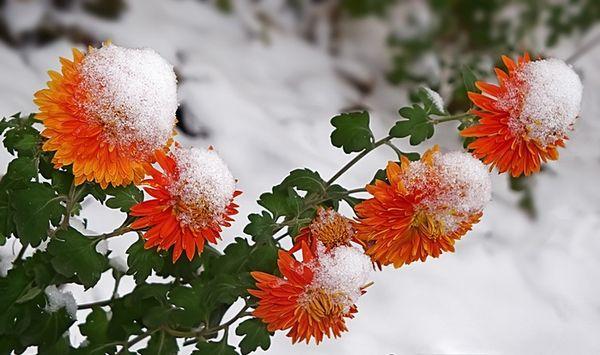
If all requirements are met, you must do the following:
- After flowering, cut the peduncles, leaving no more than 10 cm. Treat the cut site with a fungicide or iodine to prevent infections.
- Dig up the roots along with the earthy clod.
- Leave them to dry in a dry, open place for several days.
- If you suspect infestation with insect pests, treat with insecticidal preparations.
- Cover the basement (or cellar) floor with a layer of soil, then evenly spread the rhizomes over it.
- Inspect chrysanthemums 1-2 times a month.
Plants are planted back into the ground in the spring, as soon as stable warm weather is established.
Another way is wintering in trenches. The optimal width is from 50 to 70 centimeters, and the length is arbitrary and depends on the number of chrysanthemum bushes. The rhizomes must be carefully dug up and placed in the trench tightly to each other. Fill the remaining free space between the roots with nutritious soil. Plants can be stored open until the first frost.
Then it is recommended to cover them with materials at hand, for example, pieces of slate. On top you need to lay a layer of dry leaves and cover with foil. This will create an optimal microclimate with the required temperature and humidity for the whole winter.
Plant pot
An excellent choice for indoor chrysanthemums would be a medium-sized pot made of clay or ceramic material and having a laconic design. This plant has a shallow root system, so narrow and tall pots are not suitable for it. You should not choose flat, low bowl-shaped options, since good drainage must be done at the bottom.
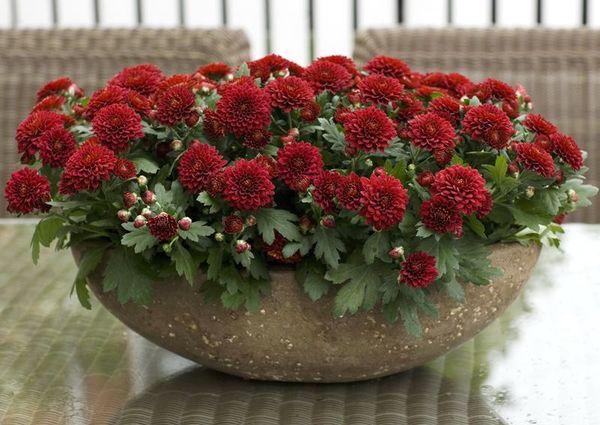
How to choose the right variety
When choosing a variety of chrysanthemums, compatibility with local climates and other factors should be considered.
The most popular varieties are:
- Regina White is an elegant snow-white flower with a stem height up to 60 cm.
- Anastasia. Large-flowered variety with a rich color range. There are pink, lilac, white, yellow and green specimens.
- Crown chrysanthemum is a bush variety with small, lush inflorescences that have a white or light green color.
Diseases and pests
Pests and diseases are dangerous for the flowering of chrysanthemums. Therefore, it is necessary to fight them in a timely manner, choosing effective methods.
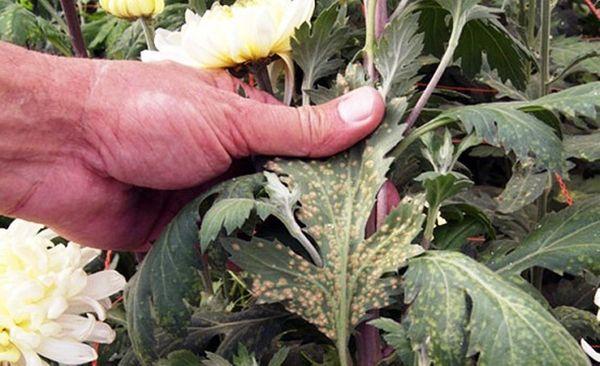
Root rot
The causative agent of root rot in chrysanthemums is the parasitic mushroom complex Rhizoctonia Solani. The disease develops in conditions of close planting, excessive humidity and too high temperatures.
As a fight against infection, it is necessary to carry out the procedure for disinfecting the soil with "Basamid" or "Formalin". For prevention, it is necessary to maintain a favorable balance of air and water regime.
Baldness of buds
This problem can be caused by various factors - diseases, pests or violations of the rules of flower care. In any case, if the chrysanthemum buds develop poorly or are completely bald, all flower stalks must be removed.
Rust
The characteristic brown spots on the shoots, flowers and leaves indicate infection with a fungal infection such as rust. All infected parts of the plant must be removed and treated with fungicidal preparations.
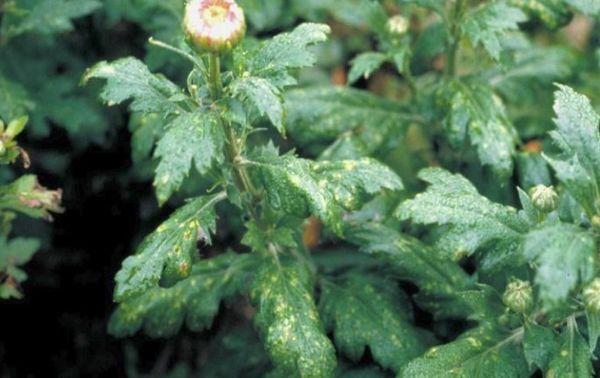
Septoria
Another dangerous disease of a fungal nature. The infected parts of the plant first acquire a brown tint, then turn black and begin to die off. The solution will be the destruction of the affected areas and subsequent treatment of the plant with "Fundazol" or another antifungal agent. To prevent infection of other plants, the diseased specimen must be quarantined for two weeks. After the course of treatment, the flower should be rinsed with a warm shower and watered.
Aphids, scale insects, spider mites
To combat these pests, drugs "Antikleshch", "Fitoverm", "Neoron" are effective.You can also use folk remedies for spraying plants - an infusion of garlic and onion husks, a decoction of yarrow and dandelion roots, as well as a solution of laundry soap.
Artificial stimulation of flowering
If the late varieties of chrysanthemums do not have time to bloom, methods of artificial stimulation of flowering can be used.
Special growth and flowering stimulants available in gardening stores and departments can make plants bloom ahead of time. They must be used according to the instructions so as not to harm the chrysanthemum.
The second method involves periodically pruning the bushes. As a result, buds will grow faster.
